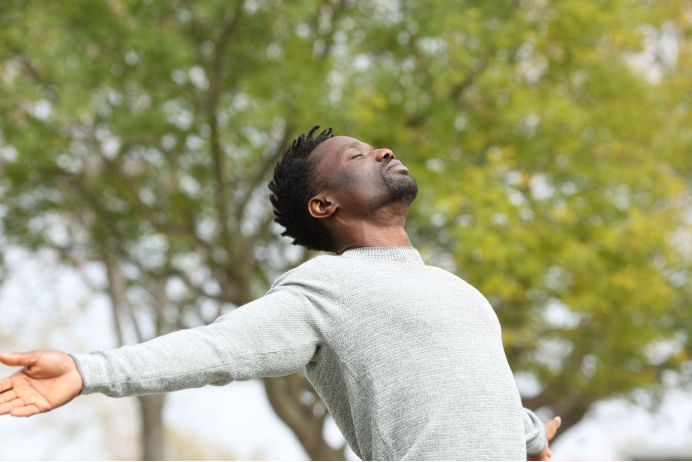What Does Mindfulness Mean?
Mindfulness has become such a popular phrase that you’ve almost certainly heard of it. If you haven’t thought about it in your own life yet, you probably at least know someone who says they practice it.
But what is mindfulness?
The term might sound intimidating, like a new exercise regimen that comes after several unsuccessful attempts to get started. You might think of it in that context, but mindfulness is quite different. Starting to be mindful doesn’t have to be scary!
Let’s explore what mindfulness is, how it works, and why it might be worth trying.
What Does Mindfulness Mean?
Mindfulness is a state of awareness in which you notice your feelings, your thoughts, and events in the environment around you.
Maybe you know what it means to be “mindful” of something. Mindfulness is a general attitude in which you try to be mindful of yourself and the moment you’re living in. Instead of enforcing strict focus or judging yourself and your environment, mindfulness promotes a neutral acceptance of the present.
People commonly conflate mindfulness and meditation but they’re not the same. Mindfulness refers to the state of thinking and awareness, while meditation is a type of activity that involves deliberately quieting the mind.
Instead of trying to limit thoughts or prevent your mind from drifting, mindfulness meditation asks you to acknowledge your feelings, thoughts, and physical sensations and accept them.
You can open yourself up to new ways of looking at situations through mindfulness, meaning you can also open yourself up to being more forgiving
Mindfulness Is a Different Way of Thinking
You might be wondering how mindfulness is different from the way you normally think about the situations you find yourself in. A mindful state is quite different from your typical attitude and could help you make different, more thoughtful decisions.
Normally, you might spread your attention across dozens of tasks and worries while missing out on much of the present moment. You might react to a challenge or a wrench in your plans by fretting about worst-case scenarios and considering giving up on the whole endeavor.
When you’re in a mindful state, you can look at a situation from a different perspective—almost like you’re separating yourself from the emotions of the situation. From that vantage point, you have more power over your negative thoughts, emotional responses, and a better view of the whole situation.
Being mindful involves several major qualities.
Awareness
Mindfulness activities—which can include meditation—involve stimulating awareness. During mindfulness exercises, you’ll deliberately notice things that you might not otherwise, such as noises, smells, physical feelings, and your drifting thoughts.
Then, you’ll try to think about how those stimuli make you feel. Does some physical discomfort cause you to feel stressed? Does a persistent noise distract you or is it a comforting presence? Do your thoughts keep wandering to a specific subject, and why do they?
Becoming aware of triggers and responses can help you prepare yourself both for things that you enjoy and tasks that you dread.
Presence
In addition to honing your awareness, mindfulness also involves acknowledging the present moment and all its imperfections.
Complaining about being uncomfortable is usually unproductive. But being mindful of what’s happening in the world around you—including sounds, smells, and other conditions that might make you feel uncomfortable—makes it easier to accept some parts of a situation while knowing how to avoid other parts in the future.
Mindfulness is not religious or institutional and it doesn’t have specific rules or guidelines for success. It’s a very open-ended attitude and activity, and that’s one of its greatest strengths.
Acceptance
Mindfulness aims to help you cope with stressful situations by preparing you to be less reactive and take more time to consider how best to solve a problem and manage stress.
Acceptance is a key aspect of reacting in a mindful way. When you train yourself through mindfulness to evaluate situations in a calm and relatively neutral manner, you build skills that can help you become a level-headed decision-maker.
In addition to improved decision-making skills, mindfulness may play a part in how you react emotionally to stress, too. Acceptance and the ability to see yourself from a different perspective are important to showing empathy.
How Mindfulness Works
There is no “success” or “failure” in mindfulness, just like there’s no correct or incorrect way to experience it. Simply by attempting to be mindful, you are being more mindful than before.
That’s the goal of mindfulness—to change your attitude toward yourself and each moment you live through so that you’re more aware of what you’re experiencing its implications and its challenges.
Mindfulness Meaning: Attitude or Activity?
Mindfulness refers to a general attitude, but it can also involve specific activities that promote and develop the attitude.
First, there’s the state of mind that you can inhabit throughout the day, thinking, seeing, speaking, and reacting in mindful ways.
Second, there are mindfulness activities, which you perform at dedicated times to help increase your ability to maintain that constant mindfulness.
You can think of it as the relationship between exercise and cardiovascular endurance. During a long day walking around an amusement park or doing a physical occupation, your body is experiencing a constant state of work. However, you’re not doing planned exercise.
The 30 minutes of exercise you do 3 times per week, on the other hand, is to help build the endurance you need for those long days on your feet.
Developing Mindfulness “Skills”
While there’s no true measure of success when it comes to mindfulness, you can improve your ability to achieve a mindful state and gain a deeper understanding of your mind and body.
“Practicing” mindfulness is an apt phrase because actively focusing on being mindful is the best (and perhaps the only) way to gradually hone the skill.
What does getting better at mindfulness techniques look like?
You may notice that it becomes easier over time to recognize when your mind drifts away to distractions or stressors and gently refocus on the present moment.
The lack of a clear success marker can also be frustrating to some people when they’re first attempting to be more mindful. In a physical exercise, such as weightlifting, you can easily chart your progress in terms of steadily increasing weight and reps. However, there are no such progress markers for mindfulness.
Increasing the time you can meditate is no clear indicator that you’re meditating more deeply, and you’re not alone if you feel too busy to set aside more than a few minutes per day to meditate.
But this is where you can find another sign that your mindfulness skills are improving: you can more easily accept that lack of a strict measurement system. Once you become used to the idea that there is no finish line to finally cross, you can find more enjoyment in the process.
Finally, turning mindfulness into a habit is one of the most important indicators that you’re becoming more comfortable with the meditation practice. To help solidify the habit, you can use a white noise machine to block out distractions or an essential oil diffuser to make your environment as comfortable as possible.
When mindfulness is a regular part of your day, you’re in a better position to maintain an aware but accepting attitude.
Common Mindfulness Techniques to Practice

Mindfulness as a general attitude is something you can incorporate into almost anything you do on a daily basis.
But there are also specific exercises that are meant to promote a peaceful state that’s more conducive to mindfulness, especially for those just starting their journeys.
These include deep-mindful breathing exercises, seated meditation, walking meditation, and other techniques. You might also incorporate guided meditations and expressive activities, such as writing and painting, into your mindfulness routine.
The Purpose of Mindfulness
By now, you’ve hopefully realized that mindfulness isn’t supposed to be a difficult or strenuous activity. In fact, that’s almost the opposite of its intended effect.
So what does this easygoing meditation practice do for your emotional wellness and overall mental health?
You’ll discover that the most noticeable effects of mindfulness have to do with your attention, mind-body connection, and perspective.
Mindfulness may contribute to some general benefits for your overall attitude and emotional wellness, including the following:
- Greater appreciation for the small events or details of everyday life
- Better understanding of what causes stressful situations and, therefore, opportunities to avoid them
- A different perspective on stressful responsibilities that may result in more motivation
- A stronger ability to appreciate the world around you and the feelings inside of you
When you have a better understanding of your feelings and what influences them, you may be able to better consider important decisions and take advantage of opportunities without feeling overwhelmed.
Viewing events and daily moments from a different perspective may also help you examine challenges and shift your thoughts to a more positive outlook. Further, you can use your mindfulness habit to think about what you’re grateful for and acknowledge the minor successes throughout each day.
What is Mindfulness Good For? Being You
Unlike many mental health trends, mindfulness has a long history of usage around the world, and it isn’t something that you can succeed or fail at.
Instead, mindfulness is an observant, accepting attitude that may help you better understand what makes you the person you are. In doing so, you might just find ways to make that person a little better.
Medical Disclaimer: This content is provided for informational purposes only and is not intended to be a substitute for professional medical advice, diagnosis, or treatment.
Sources





